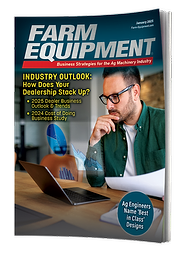In today’s newscast we look at how El Niño is impacting the U.S. growing season, an update on Titan Machinery, the results of the latest Precision Farming Dealer benchmark survey and Kubota’s fiscal 2015 financial results.
On The Record is brought to you by GBGI Inc.

|
GBGI Inc. has been developing hubs and spindles for the agricultural industry since 1997. Their product offering includes IDA-X, the hub assembly with a robust design and ductile iron construction that substantially increases the load capacity and impact resistance compared to conventional fabricated welded assemblies.
We're interested in getting your feedback. Please feel free to send along any suggestions or story ideas. You can send comments to kschmidt@lesspub.com or to cvandermause@lesspub.com.
I’m managing editor Kim Schmidt, welcome to On the Record. Here’s a look at what’s currently impacting the ag equipment industry.
|
FARM
AFN: $45.80 +0.05 |
Strongest El Niño in 50 Years
El Niño has been strengthening over the last month, and meteorologists with AccuWeather say by this winter it could be the strongest of the last 50 years.
For California, a strong El Niño in winter means the state’s wet season will be wetter than usual, explains Iowa State climatologist Elwynn Taylor. He says California has been getting half to a third of its normal winter precipitation in recent years. However, he cautions, Northern California isn’t greatly affected by El Niño.
While El Niño influences Southern California, it doesn’t rely on the mountains in Northern California for its water. It is the Colorado River conditions that are meaningful for southern California. Unfortunately, El Niño usually diminishes the snowpack in southern Colorado, Taylor says.
He says El Niño is a mixed blessing for California. On the positive side it means there is more local moisture. But it also means the Colorado River won’t be receiving as much water. He says it offers an emotional relief, but that may be about it.
Looking at the Corn Belt, Taylor says El Niño is the Midwest’s friend. He says heat, more so than a lack of water, is damaging to crops. When temperatures are more normal for the growing season, less water is actually needed.
“If there is an El Nino going on through the growing season, the odds of having an above average, above trend line corn and soybean yield for the nation is 70%. So it’s better than 50-50, that’s why we say it’s our friend. This is because an El Niño tends to reduce the chances of oppressive heat and so it’s the heat that’s the real reason in the Midwest that an El Niño is a good thing.”
Taylor says this current El Niño began in late winter to early spring of 2015. It’s expected to last through the rest of this growing season and into the next one, he says.
Dealers on the Move
Dealers on the Move this week include Allan Equipment Manufacturing, John Fabick Tractor Co. and FABCO Equipment Inc.
Allan Equipment Manufacturing in York, P.E.I., is now a Claas dealer. The dealership will carry all Claas equipment lines including Lexion combines, Jaguar forage harvesters, Xerion tractors, balers and hay tools.
Cat dealers John Fabick Tractor Co. of St. Louis, Mo., and FABCO Equipment Inc. of Milwaukee, Wis., have finalized a merger under the name Fabick Cat. The company will be headquarted in St. Louis and will have 37 locations in Missouri, Illinois, Kansas, Oklahoma, Michigan and Wisconsin.
Titan Machinery Update
RW Baird recently held an investor meeting with Titan Machinery management.
“While higher corn prices lifted everyone’s mood, crop prices and equipment demand going forward remain uncertain,” says Baird analyst Mig Dobre.
Dobre notes that management seemed encourage by the higher crop prices and relatively good growing conditions. That said, new equipment demand remains challenged in the near term and the late model used equipment “glut” continues, he adds.
Looking at equipment financing, Titan management pointed out that while farmers’ balance sheets remain quite healthy, lenders are basing new equipment financing decisions on profit and loss and cashflow dynamics, Dobre says.
“Customers with solid balance sheets have actually been turned down for equipment financing — this is particularly relevant in financing used equipment, a key goal for dealers given excess inventories,” he says.
This focus on profit and loss and cashflow, Dobre says, underscores the importance of commodity prices going forward as a key driver of stabilization and improvement in equipment demand.
Now here’s Technology Editor Jack Zemlicka with the latest from the Technology Corner.
Precision Pace Slows in 2015
In the midst of a downturn in the agricultural equipment market, precision farming dealers are faced with a changing landscape for technology sales, as customers become more discerning with their immediate on-farm expenditures.
By no means is precision ag a shrinking industry, but dealerships are adapting and evolving business strategies to emphasize recurring services and complementary products rather than one-time equipment sales.
The 3rd Annual Precision Farming Dealer benchmark study reflects this ongoing transition. Based on responses gathered during the first quarter of 2015 from 21 different states and Canada, fewer dealers expect this year to be as profitable as 2014. More than 58% of dealers reported precision revenue increases of at least 2% in 2014 vs. 2013, with 30.3% indicating a jump of 8% or higher.
But dealers are less optimistic this year. Only 19.7% of respondents forecast precision sales of 8% or more in 2015, while the percentage of dealers who expect revenue growth of 2-7% remained the same at 28.8% year-over-year.
The percentage of respondents who anticipated little or no change in revenue this year, compared to 2014 increased to 25.8% from 16.7% between 2013 and 2014.
Perhaps some good news is the percentage of dealers who expect revenue to decline this year is less than 2% higher than in 2014. And those forecasting a revenue decline of 8% or more remained unchanged at 10.6% compared to 2014.
Overall, nearly one-half of dealers (48.5%) expect revenues from the sales of precision ag equipment and service to increase 2% or more in 2015. This compares with 59.1% of dealers who indicated increases of 2% or more a year ago.
The complete 2015 benchmark study report can be found in the summer print edition of Precision Farming Dealer or online at precisionfarmingdealer.com
Kubota Continues Push into Big Ag
On the heels of a 5.2% increase in revenues during its fiscal year 2015, Kubota Corp. says it plans to push ahead with further expansion into the large ag machinery market.
For fiscal 2015, Farm Equipment & Engine revenues were up 3.2%, with overseas revenues from the segment up 15.2%. However, domestic Farm Equipment and Engine revenues were down 26.3%
Revenues from Farm & Industrial Machinery, which includes construction equipment, were up 5.4% for the year. Domestically, this segment was down 22.6%, but overseas revenues were up 16.7%. The majority of Kubota’s overseas business comes from North America and Europe.
With more increasing revenues on the horizon, Kubota reiterated its plan to build a full line of broadacre equipment, saying it plans to develop its business activities by “expanding its presence in the farm machinery market for upland farming as the core of its growth strategy.”
Kubota adds, “The company is further expanding its product lineup and taking initiatives to ensure product quality, cost and delivery that will surpass other companies in the field and thereby position it as one of the major players in the farm equipment business.”
Ag Equipment Archives
In the mid-‘70s, competition was steep for high-horsepower tractors, with each major company wanting to be the one to produce the most powerful tractor. In 1977, Versatile took the competition to another level with its 1080 “Big Roy” tractor. The 1080 featured a Cummins engine that could produce 600 horsepower, which was nearly double what the other big tractors of the time were producing. To accommodate the hefty 57,580-pound weight of the tractor, the machine was set with 4 axels and eight wheels with a pivot in the middle.
However, there were virtually no implements that would fit a tractor the size of “Big Roy,” and excessive damage to the tire lugs and casing was caused by the steering action. Development on the giant tractor was ultimately abandoned.
As always, we welcome your feedback and story suggestions. You can send them to kschmidt@lesspub.com. Thanks for watching, i’ll see you next time.






